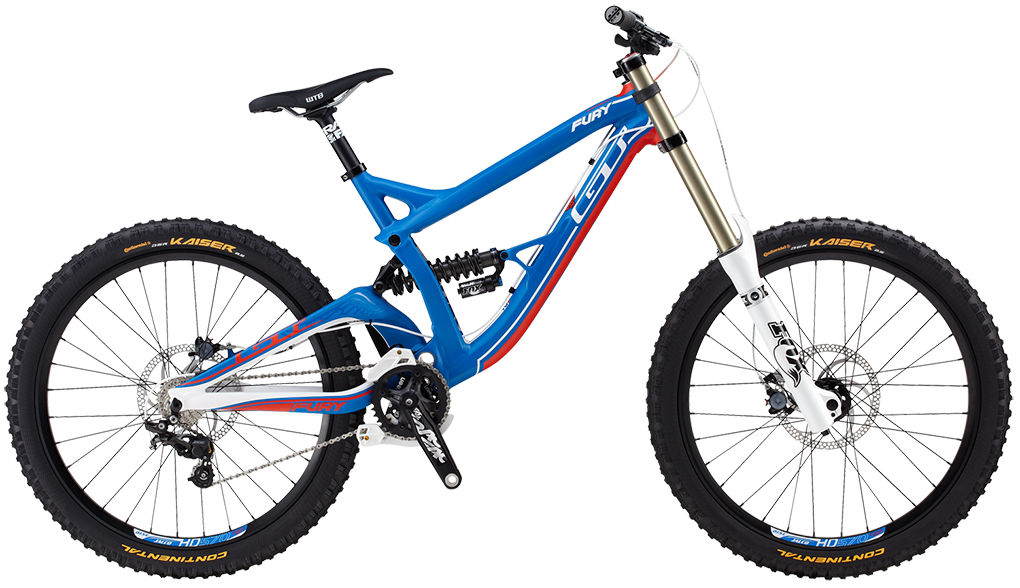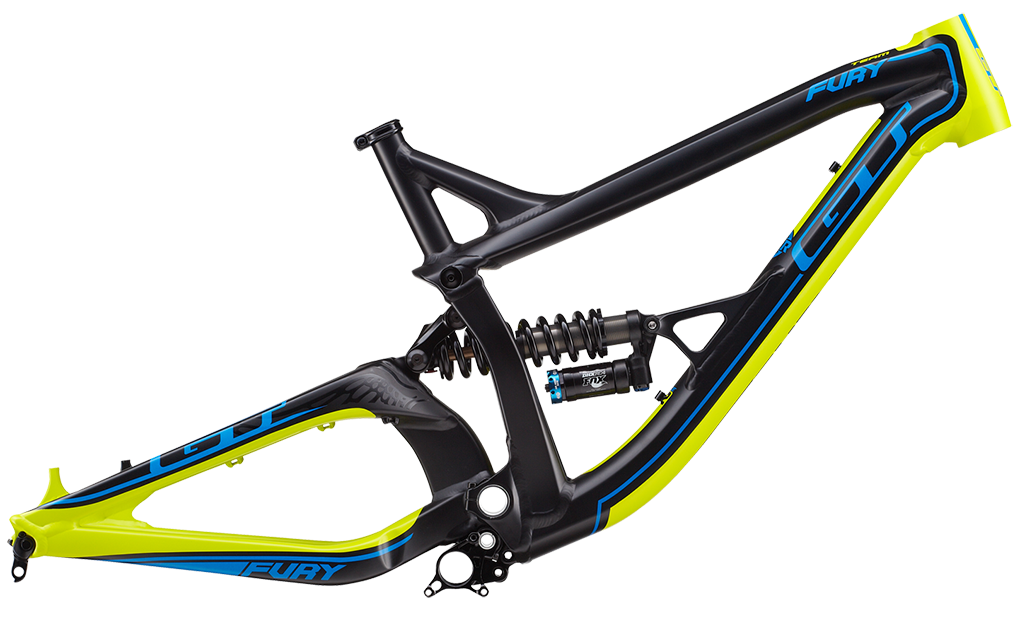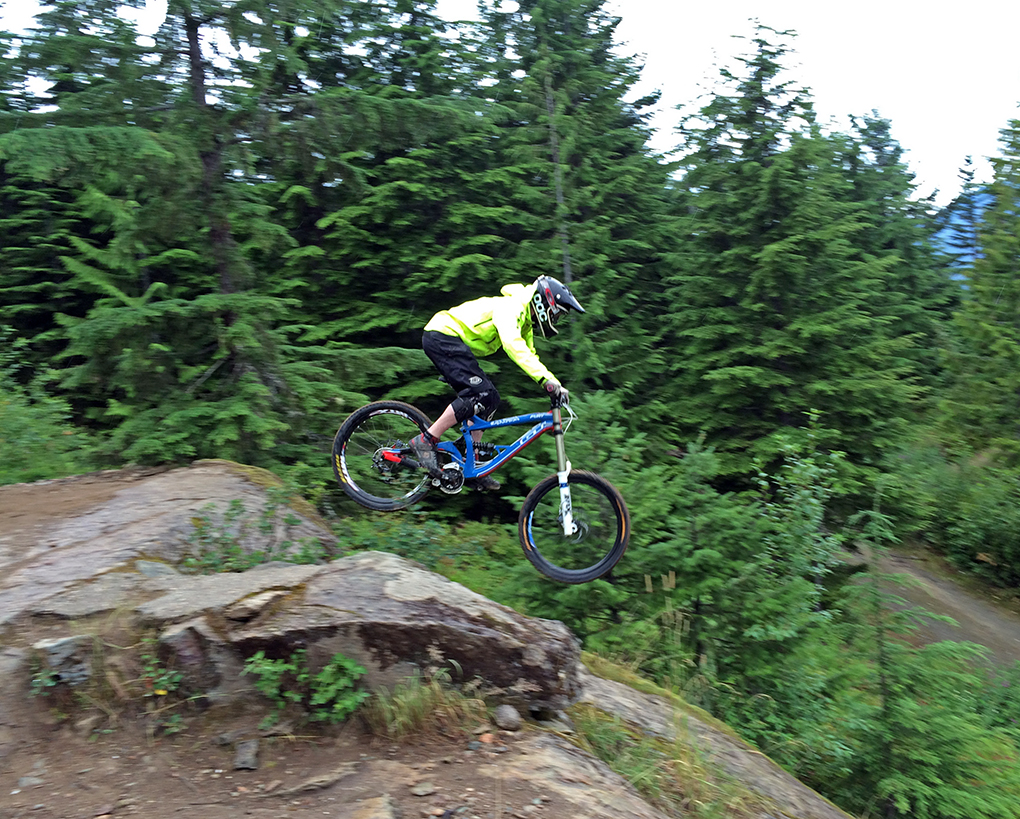
Bike: 2014 GT Fury Expert
Size Tested: Medium
MSRP: $4340
Bike Weight (as tested w/ 530g Time Z Pedals): 41.2 lbs
Geometry: (see page 3)
Build: (see section below)
MSRP (as tested): $6026
Reviewer Info: 5’ 8” 160 lbs
Days Tested: 6
Test Location: Whistler, BC
Of all the bikes we took on our test trip to Whistler last month, the GT Fury was the one I was most interested in riding. Why? Partly because it’s geometry is fairly different from all the other bikes we rode; partly because there are some interesting things going on with the bike’s rear linkage; and partly because, over the course of my time riding bikes, I’ve watched GT as a company go from the top of the pile to the bottom.
It’s no secret that GT has gone through fits and starts over the years. In the mid 90’s GT was a leader in the sport and made some pretty damn good bikes. But then hard times hit, GT went bankrupt, eventually got bought up by Dorel Industries, and the future of the company was uncertain. GT kept making bikes, though, and their i-drive suspension platform did reasonably well. But as the years wore on, GT’s innovation seemed to lag.
Fast forward to 2014, and enter the newly revised line of Fury DH bikes, a group significantly different from the prior iteration of the Fury, and proven capable by some fast World Cuppers on the GT team.
Gone is the somewhat tall, gangly looking Fury of the past. The new Fury is long, low, and generally massive looking. The essentials of the i-drive system remain (though GT has now lengthened the label to “Independent Drivetrain”), and the linkage is neatly tucked away in a clean package around the frame’s bottom bracket.
Frame Construction & “Independent Drivetrain” Suspension Design
The new Fury is aluminum, which is interesting considering that the older version of the bike was carbon. Yet despite the massive aluminum tubes used on every part of the Fury, the new frame is reportedly significantly lighter than the older carbon version.
What all those huge tubes compose is really a fairly simple single-pivot frame—i.e., there is no linkage between the frame’s front triangle and the rear axle. As the suspension compresses, the rear wheel travels in an un-modified arc around the pivot, slightly above and in front of the bottom bracket. Compared to the old Fury, the new frame’s pivot is substantially lower. While that revised pivot placement might help a bit with pedaling characteristics and slimming down the independent drivetrain linkage, it also makes for a slightly less desirable wheel path, which I’ll discuss below.

The basic premise behind the Independent Drivetrain system is to get the desirable suspension characteristics of a single pivot layout while working around the less desirable pedaling characteristics that usually come along with it.
The pivot placement on most bikes, including the Fury, has the rear wheel traveling in an arc. At the beginning of that arc, the wheel is traveling slightly rearward, which is a good thing when you want the wheel to get out of the way of bumps. But that slightly rearward arc does weird things with your drivetrain; the distance from your chainring in the front to your cassette in the back increases as the suspension compresses, so it will have a tendency to jerk on the chain when you hit an abrupt bump. It also means that when you’re trying to pedal through bumps, the force that you’re putting into the chain is fighting against the suspension movement.
One possible way to address this problem is to move the frame’s pivot very close to the bottom bracket (this is what Trek has done with the suspension design of the Session 9.9, for example). This minimizes that rearward portion of the wheel-arc, but it simultaneously negates some of the desirable suspension characteristics that you get with a higher pivot placement.
GT’s solution to this problem, and what their Independent Drivetrain design is all about, is to put the bottom bracket on a little piece of floating linkage so that it may move freely in conjunction with the rear axle. So when you smack a bump and the suspension compresses, the bottom bracket moves with it, roughly mirroring the axle path. The “floating” bottom bracket only moves about 10mm, so I never noticed it shifting, but it did seem to provide some real benefits to how the bike handled, which I’ll get to below.
Fit & Sizing
Before moving on, it’s worth taking a moment to look at how spectacularly long the Fury is. In a size Medium (which I rode), the horizontal top tube is 657 mm (25.86”), the reach is 438 mm (17.24”) and the wheelbase is a massive 1230 mm (48.43”). Even as modern bike geometries trend toward longer front ends, those numbers are still pretty unusual.
Compared to a Medium Specialized Demo (the front end of which I’d call average or just slightly on the long side), the reach on the Fury is a modest 8mm longer, but the wheelbase is 39mm (1.5”) longer, and its horizontal top tube is a whopping 77mm (around 3”) longer.
It should also be noted that a medium Fury is the second largest bike in the Fury size run, which goes from Extra Small through Large (rather than Small through Extra Large, like many other companies). So if you’re particularly concerned about the length of the Fury, it might be worth considering sizing down from your normal frame size.

Also contributing to the length of the bike is a 63 degree head angle, greater than any of the other bikes we rode at Whistler and a lot of other modern DH bikes. The Fury’s bottom bracket is relatively low, at 349 mm (13.7”), which is particularly noteworthy since the frame gets 220 mm of travel – a bit more than many other DH bikes that tend to come in around 200 mm.
The one relatively normal measurement on the Fury is the 432 mm (17”) chainstays. They’re longer than the Specialized S-Works Demo 8’s, and just a bit longer than the Trek Session 9.9’s.
With all that said, I felt remarkably comfortable on the size Medium Fury that I rode.

What do you think can you attribute to the amount of pop in each bike – the Fury and the Podium? You mention both pop well, but heading over to Linkagedesign.blogspot.com, shows two very different leverage curves – the Fury being very linear and the Podium being very progressive. Very curious on your thoughts.
As an side, looking at the leverage ratios, It seems like the Podium would be the choice for big hits and the Fury being the choice for all-out DH speed. Did you notice much bottom-out harshness on the Fury when landing with high impact compared to the Podium?
Hey Brian
That’s a great question and something I’ve been trying to wrap my head around. I don’t have any clear answers as to why those bikes seem to pop well, and I suspect that the answer really can be attributed to a few things. Here’s my take:
In a general sense, I usually think of single pivot bikes (like the GT) as having lots of pop. I also usually think of “platform” type linkages (VPP, DW link, etc.) as having a lot less pop. The basic reason for this (I think) is that, like you said, single pivot bikes like the GT tend to have fairly linear leverage curves, whereas the platform type bikes oftentimes have a heavily modified leverage curve to help out with the bike’s pedaling characteristics. And while that platform works well to keep the bike pedaling efficiently, it tends to make it harder to load up the suspension and get a predictable pop off of jumps.
Like you said, the Knolly seems to have a somewhat progressive leverage curve, but it doesn’t have the sort of modified curve that you see on (for example) a Santa Cruz Nomad. So I think that, even though it’s a bit different than the GT, it’s still easily predictable and it doesn’t do anything drastically different throughout the travel. In other words, as you compress into a jump, the suspension gets progressively stiffer on the Knolly whereas the GT gets stiffer in a more linear manner, but both get stiffer in a predictable way that allows you to time your preloading and weight shifts accordingly.
The other thing I’d point to is the rear shock. Both the Knolly and the GT had Fox shocks (RC4 on the Knolly, RC on the GT), and I think those damper units just give a bit more pop than, for example, the Ohlins that was on the S-Works Demo we rode (which was extremely reluctant to leave the ground). I’m speculating here, but I would guess that the compression circuits in the Fox are a bit less dialed in than on the Ohlins, which means that it’s easier to predictably preload the shock into the face of the jump. The Ohlins, which is without a doubt better at smoothing out rough trail, seems to have some more complex damping going on that’s more concerned with sorting out bumps of all sizes, but at the cost of not having that super consistent compression support that helps you get a lot of pop off of jumps.
As to your other question on bottoming out the Fury – yup, I did that. When I first got on the Fury, it had a 350# spring that I was blowing through pretty badly. I switched that out for a 400#, which helped things a fair amount; I’d still bottom it out on hard hits, but it wasn’t nearly as harsh. If I were to own that bike, I’d probably experiment with throwing a 450# spring on it. But more than anything, I’d just like to have a higher end shock on it. The demo that I rode had a Fox RC (which is stock on the expert model), and while that shock got the job done reasonably well, that bike would certainly benefit from the bottom out adjustment that you get on a Vanilla RC2 or RC4 (which comes stock on the Fury Team and World Cup, respectively).
Hey there, I read your comment about the rear suspension complaints on the giant glory. I am actually interested in building up a glory and just wanted to get your thoughts on it. It will be the new 27.5 version, so idk if you have seen or have any experience with the new 2015 version, but just wanted to get your input. I am 5’8″ and look like we have very similar riding styles.
Hey David,
I’m wrapping up my review on the Glory now, so that should be up on the site in not too long. Here’s the executive summary: I rode a 26″ wheeled Glory from the Whistler rental fleet. I disliked it more than pretty much any other modern DH bike that I’ve ridden, but I think a lot of its problems came from a wonky rear shock (which was a Vivid R2C). The rear wheel tended to hang up in holes, the suspension felt super harsh, and I struggled to keep the front end underneath me. But given that lots of fast guys seem to get along just fine with the Glory, I’m reserving final judgment until I ride a different one with different suspension.
Thank you so much for getting back to me, even though is not what I wanted to hear lol. I am hoping they have there new bike a little more figured out. There is also the problem that they have changed the frame sizing for 2015 as well. Let me know if you hear anything about the new version or get a chance to ride one. Trying to decide between the glory and the 27.5 demo aluminum.
Thanks again for your help
I’m hoping to swing a leg over one of the new Glorys at Interbike (in 2 weeks). If that works out, I’ll post my findings.
That would be much appreciated!
Talking again abou the fury!
For 2015 model, there are a lot of changes
I’m 1,78m-5 10″
Some people says that i have to choose s size
But this year the bike has 618 horizontal top tube on M
And 592 on S.
I I choose the S, will the bike be too much short?
Hey Joan,
Sizing on the Fury is a bit tricky. The 2015 shows a shorter effective top tube, but it also has a steeper seat tube angle (73 for the 2015 vs. 70 for the 2014). From talking to the guys at GT, it sounds like they had an issue with the tire hitting the seat at full bottom out, which would explain the steeper seat tube, as well as the slightly shorter travel (210 vs. 220 mm) on the 2015 27.5″ version.
GT doesn’t list reach in their geometry tables, which is a shame since I think, particularly for DH bikes, reach is one of the most useful numbers when it comes to assessing a bike on paper. Top tube length is most apparent when you’re sitting down, and (hopefully) you’re not in the saddle all that much on a DH bike. Reach is more useful since it measures the horizontal distance from the BB to the head tube – basically how stretched out the bike will feel when you’re standing up. At 438 mm, the 2014 had a long reach. Running the calculations on the 2015 shows it being slightly shorter at around 430mm, but that’s still not short by any means.
So, getting to the point, I’m a bit shorter than you (5’9″) and I got along with the medium pretty well. If I was going to buy a Fury, that’s probably the size I’d get. I generally like bikes to be on the longer side of things, which is really just a matter of personal preference. If you like shorter bikes I’d probably size down, but otherwise, I’d stick with the medium.
Hey Noah,
Trying to revive this thread. Any frame size recommendations for someone that is 6′
218 lbs for a 2015 fury?
I typically ride large demo 8s.
Thoughts?
Hey Tyler,
Comparing the Fury’s geometry to the Demo’s depends a little bit on what year Demo it is. It also gets a bit more complicated because the Demos used to be small / medium / large, but on the newer Demos they’re short / medium / long / extra long.
So with that in mind, on the older Demos, sizing on a medium Fury would fall about halfway between the medium and large Demo. On the newer Demos, a medium Fury falls in between a long and extra long. The large Fury is effectively a half size bigger than the largest Demo (old and new).
So, long story short, if you’re coming off a large Demo, I’d say go with a medium Fury if you’re looking for a slightly smaller bike, and go with the large if you’re looking for a slightly larger bike. I’m 5’9″, and I didn’t feel like the medium was too big for me, but it did take a little getting used to having a longer bike. It’s also worth noting that when I was riding the Fury, I was switching back and forth with a medium Demo. The Fury definitely feels bigger, but not enormously so.
Personally, I like a DH bike to be a little bigger, but it also depends on what and where you’re riding; the big bike can feel cumbersome in tight spots and it’s a little less whippy on jumps, but it’s super stable at speed.
Noah,
Thanks for the reply!
Im fairly new to the sport but grew up racing motocross. From my understanding i’m on the verge of a medium or large and end up riding larges.
I have been renting large 2015 650b demos (carbon and Al) at angelfire. So after reading your post, my understanding is that the medium will be actually be slightly bigger than a long but smaller than an extra long demo 8. I think the medium would be a good fit then if that’s the case.
Once again, thank you!